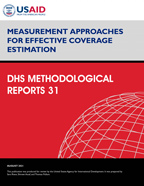- PUBLICATIONS
- JOURNAL ARTICLES
- ACCESS PUBLICATIONS
Publications Summary
- Document Type
- Methodological Reports
- Publication Topic(s)
- Child Health and Development, Health facilities/SPA surveys, Maternal Health
- Country(s)
- Malawi, Senegal, Tanzania, Nepal, Haiti
- Language
- English
- Recommended Citation
- Riese, Sara, Shireen Assaf, and Thomas Pullum. 2021. Measurement Approaches for Effective Coverage Estimation. DHS Methodological Reports No. 31. Rockville, Maryland, USA: ICF.
- Download Citation
- RIS format / Text format / Endnote format
- Publication Date
- August 2021
- Publication ID
- MR31
Download this publication
There is no printed copy available to order.
